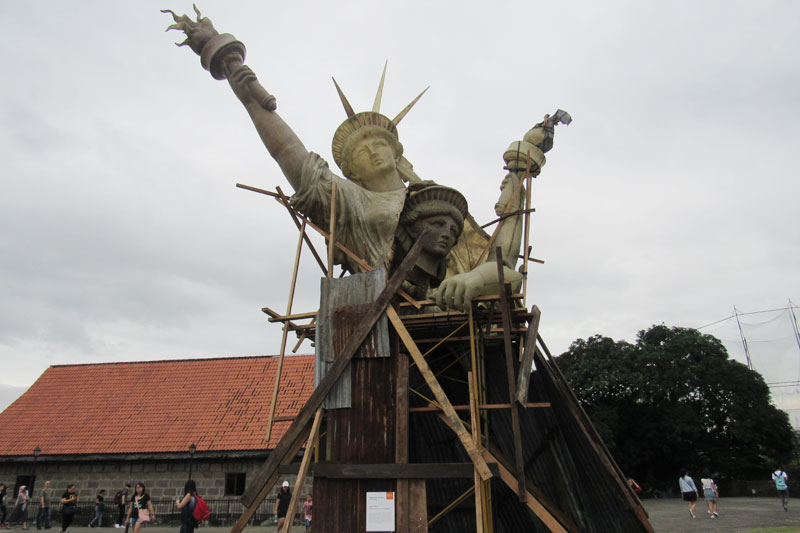The ‘Bayan’ In The Biennale: Reconstructing the memory of Intramuros

Kawayan de Guia’s “Lady Liberty” at Fort Santiago, made with scrap materials from Intramuros, alludes to the fall of the Americans during World War II. Photo by Pristine de Leon
"Filipinos, Filipinos, Filipinos,” says Carlos Celdran of the audience he intends to attract in what he calls his dream project: the first Manila Biennale. “We are doing this for ourselves. Maybe the world can come and watch, but really, we’re addressing our own history here, we’re addressing each other, we’re addressing the city. Our primary audience is ourselves.”
Unlike how Biennales usually are in other parts of the globe — inviting foreign artists and subsequently foreign guests and foreign media into their cities — here the artists are mostly Filipinos, and so are the audiences that Celdran hopes would come in the month-long festival. The Manila Biennale runs from Feb. 3 to March 5, with works that can be viewed at Baluarte de San Diego, the Jesuit Mission House, and Fort Santiago. Here, Intramuros itself takes the starring role.
“We invited artists to propose works with the theme ‘Open City,’” says Ringo Bunoan, the head curator of the Biennale working alongside curators Cocoy Lumbao, Alice Sarmiento, and Con Cabrera. “Majority of the works referred to that moment in our history when Manila was destroyed at the end of World War II. Manila became a ground zero and this is the main point of departure for the exhibition.”
The history of Intramuros is said to be a narrative of compression, exodus, and fragmentation — of compressing communities within the walled city, and of bombings prompting an exodus that gave rise to poverty and the loss of Manila’s center. But this is all just textbook data. Two artists — Renz Baluyot in his mixed media installations and Hikaru Fuji in “Record of the Bombing” — seem to tease out a question that we all want to ask: How exactly do we reflect on something that we virtually have no memory of?

Oca Villamael’s “Children of War” at Fort Santiago makes use of scavenged dolls from the Payatas dumpsite. It serves as a commentary on the horrors of war, dispossession, and the loss of innocence.
Here, works serve to activate the different relics and spaces within the city. Various works in video, sound art, and even performance, fill up the floors of the Mission House — showing what can be done when the space eventually becomes the ecclesiastical museum of the Intramuros collection.
Some works serve, if not to re-enact, then to make us re-encounter the events and anomalies associated with war, and the air of disquiet that their resonances still provoke. Take for instance Gerardo Tan’s “Sear to Open” echoing the blinding light of the Nagasaki and Hiroshima atomic bombs that had once turned masses of bodies into shadows.
Some works stand like memorials, serving to commemorate nameless heroes fallen by the wayside, like Agnes Arellano’s “Angel of Death” in Fort Santiago, and Zeus Bascon’s “Dead Masks” in Baluarte de San Diego. Others allude to current-day issues. There’s Felix Bacolor’s “Thirty Thousand Liters”: 150 blue metal drums cleverly commenting on the volume of blood — and life — lost in the war on drugs. Installations reference atrocities both past and present — like monuments dedicated to history forgotten, or to history already being distorted and eroded as it happens.
In the middle of these, the artist collective Kolown intervenes and comments on the post-truth era, installing fake markers with fictional histories such as wormholes and giant robots fighting soldiers. It seems to suggest how memory of the past is just as faulty and inaccessible, as truth is now, in the fake-news age.
Beyond the references of each piece, the works directly engage with Intramuros by focusing on process, place, and participation. “The goal was to generate a dialogue between history, heritage and contemporary art,” says Bunoan, “and engage the communities in and around the walled city.” Jason Dy, S.J.’s “Procesion los Camareros” was done with the Intramuros community, with lightboxes depicting 15 pedicab drivers’ narratives of faith. Some were done with materials sourced around the city, such as Wawi Navarroza and Nicolas Combarro’s “Visible: Self-Construction and Wild Growth” and Kawayan de Guia’s “Lady Liberty.”

The minds behind the Manila Biennale: Carlos Celdran and Ringo Bunoan. Photos by Rache Go
Oca Villamael’s “Children of War” gathers dolls from the Payatas dumpsite. Beyond its initial Instagrammable appeal, the work compels us to pay attention to how the process itself is a performance of rebuilding. It is, as Celdran puts it, “like the city regenerating itself.”
Considering that this is the first Manila Biennale and issues of fundraising and bureaucracy are bound to come up, one of the Biennale’s achievements is how it promotes the possibility of artists working with a playground-like Intramuros. “It’s my dream,” says Celdran. “I really wish that more artists can come here, use this as a workspace.”
“The Manila Biennale is also artist-run,” adds Bunoan, “which makes it very different from other government-sponsored biennales… It was very difficult but it shows what artists can do when we band together for a common goal.”
Intramuros, both as a city and as a concept, is made up of retasos, debris, fragments and forgotten bric-a-bracs. The process of realizing the first Manila Biennale is a gesture of re-assembling and rebuilding. Answering how we reflect on things we have no memory of, the Biennale suggests: to remember is always to re-collect, reconstruct, and re-imagine, to carry the salvaged scraps of the past on our collective shoulders and march on with time. It’s bayanihan, and that may also be why Celdran insists on calling it a “Bayan-na-le.”



















